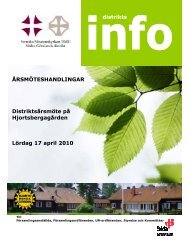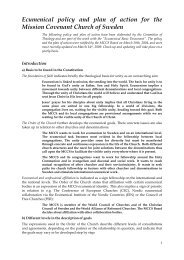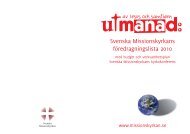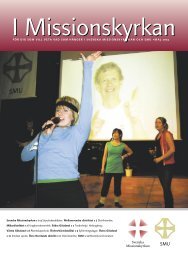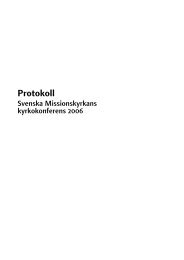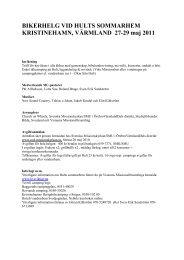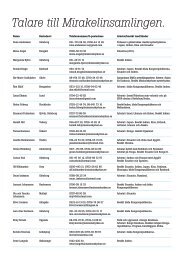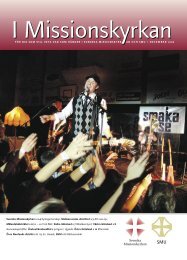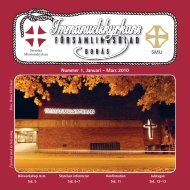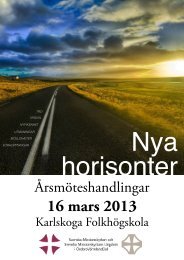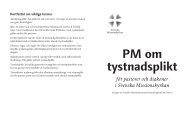Mission and Revolution in Central Asia - Svenska Missionskyrkan
Mission and Revolution in Central Asia - Svenska Missionskyrkan
Mission and Revolution in Central Asia - Svenska Missionskyrkan
You also want an ePaper? Increase the reach of your titles
YUMPU automatically turns print PDFs into web optimized ePapers that Google loves.
explanation, “I cannot allow you to travel with this letter.” 3 How <strong>in</strong>terest<strong>in</strong>g <strong>and</strong> valuable<br />
these destroyed documents would have been for the underst<strong>and</strong><strong>in</strong>g of the mission <strong>and</strong> the<br />
conditions of the missionaries is shown by a number of letters that were saved for posterity.<br />
They were written <strong>in</strong> Eastern Turkestan by various missionaries to Raquette, their colleague,<br />
<strong>and</strong> when he returned to his own country, <strong>in</strong> the beg<strong>in</strong>n<strong>in</strong>g of the 1920s, he took these letters<br />
home with him. These letters conta<strong>in</strong> a lot of details expla<strong>in</strong><strong>in</strong>g the situation <strong>in</strong> the field.<br />
The source material may seem one-sided, s<strong>in</strong>ce <strong>in</strong> most cases it was written by the<br />
missionaries themselves. As to the religious life of the people – <strong>in</strong> which area the mission<br />
came to play its ma<strong>in</strong> role - not much other material is however available. Literature about<br />
Islam <strong>in</strong> general is immense. But when it comes to Islam <strong>in</strong> Eastern Turkestan, this Muslim<br />
region <strong>in</strong>side Ch<strong>in</strong>a's western borderl<strong>in</strong>e, the general history of religion has very little to offer.<br />
And when it comes to the Swedish <strong>Mission</strong> <strong>and</strong> the evaluation of its work, there were only a<br />
few westerners, apart from the missionaries themselves who actually saw <strong>and</strong> experienced<br />
what was done. An American couple, the <strong>Asia</strong>n expert Owen Lattimore <strong>and</strong> his wife Eleanor,<br />
visited the mission stations <strong>and</strong> <strong>in</strong> their books there are some brief passages about what they<br />
observed. The British Consul-Generals <strong>in</strong> Kashgar cont<strong>in</strong>ually met the missionaries. A<br />
friendly, trust<strong>in</strong>g relationship prevailed between the missionaries <strong>and</strong> the British officials.<br />
Worthy of be<strong>in</strong>g particularly mentioned is Sir George Macartney who served as a Consul-<br />
General up to the year 1918. In one of her books, his wife, Lady Cather<strong>in</strong>e Macartney,<br />
recounts several <strong>in</strong>terest<strong>in</strong>g episodes from their time together. Several other Consuls also<br />
comment favourably <strong>and</strong> with appreciation on the mission work.<br />
Journalists <strong>and</strong> scholars from Engl<strong>and</strong>, America, Germany <strong>and</strong> Switzerl<strong>and</strong> <strong>and</strong> other<br />
countries, travell<strong>in</strong>g <strong>in</strong> the country, also came <strong>in</strong>to contact with the <strong>Mission</strong> <strong>and</strong> wrote about it<br />
<strong>in</strong> their books. Gustaf Mannerheim who later on became president of F<strong>in</strong>l<strong>and</strong>, travelled<br />
through the area <strong>in</strong> the beg<strong>in</strong>n<strong>in</strong>g of the 20th century <strong>in</strong> his capacity as a Russian officer. He,<br />
too, mentions the missionaries <strong>and</strong> the impression they made on him. The English missionary,<br />
Rachel W<strong>in</strong>gate, came to work for the Swedish <strong>Mission</strong> on a voluntary basis from 1924 to<br />
1928. Through her articles <strong>in</strong> British periodicals she made the work of the Swedish <strong>Mission</strong><br />
well-known far beyond the bounds where the missionaries reached. In the year 1927 she<br />
wrote the follow<strong>in</strong>g <strong>in</strong> a Swedish newspaper, “It is impossible to grasp the spiritual darkness<br />
<strong>in</strong> this country unless you have been there yourself.” 4<br />
Only four Swedish people “from outside” saw the Swedish <strong>Mission</strong> on the spot. They were<br />
the three explorers Sven Hed<strong>in</strong>, Nils Ambolt <strong>and</strong> Erik Nord<strong>in</strong>. Hed<strong>in</strong> <strong>and</strong> Ambolt have both<br />
described, verbally <strong>and</strong> <strong>in</strong> writ<strong>in</strong>g, their meet<strong>in</strong>g <strong>and</strong> relations with the missionaries. They<br />
became true friends of the <strong>Mission</strong>. This is also true of the fourth Swede, the Ambassador<br />
Gunnar Jarr<strong>in</strong>g, who accompanied a group of missionaries to Eastern Turkestan <strong>in</strong> 1929. He<br />
rema<strong>in</strong>ed there for some time for l<strong>in</strong>guistic research, stay<strong>in</strong>g at the mission station <strong>in</strong> Kashgar.<br />
He made a second attempt at gett<strong>in</strong>g <strong>in</strong>to the country <strong>in</strong> 1935, that time too <strong>in</strong> the company of<br />
travell<strong>in</strong>g missionaries. He was however prevented from enter<strong>in</strong>g <strong>and</strong> parted from his<br />
companions <strong>in</strong> Sr<strong>in</strong>agar. 5 Jarr<strong>in</strong>g has never tired of writ<strong>in</strong>g <strong>and</strong> speak<strong>in</strong>g with appreciation<br />
about the <strong>Mission</strong>.<br />
There are several ways of spell<strong>in</strong>g geographical names. The prov<strong>in</strong>ce for <strong>in</strong>stance is called<br />
“Eastern Turkestan” or “East Turkestan”. Referr<strong>in</strong>g to the l<strong>in</strong>guist <strong>and</strong> missionary G.<br />
Raquette, I will use the term “Eastern Turkestan” 6 . The older German spell<strong>in</strong>g of “Kaschgar”<br />
3 Interview with Moen, September 23rd, 1972.<br />
4 W<strong>in</strong>gate <strong>in</strong> Friska V<strong>in</strong>dar, 1927, p 291.<br />
5 Jarr<strong>in</strong>g, 1972, p. 264.<br />
6 Raquette, 1928.



